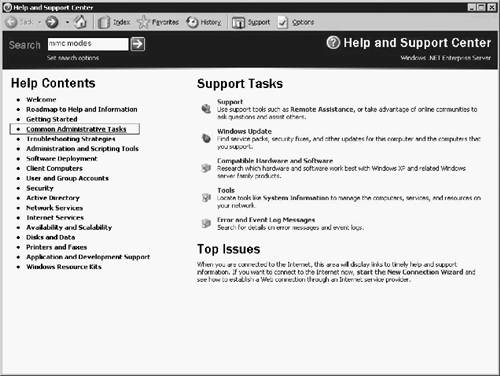|
|
|
If you are a system administrator coming from a UNIX environment, the Windows Server 2003 Help facility (Figure 4.19) makes the UNIX manual's pages pale in comparison. Even if you are moving from previous versions of Windows, you should be pleasantly surprised by the number of innovative enhancements. Anytime the end user can easily resolve computer issues, this is good news for system administrators...and there is a lot of good news here. As was the case with Windows 2000, related topics are hyperlinked, making it very easy to drill down to a subject or move laterally to related information. Within any Windows Server system console it is possible to jump to the Help and Support Center by clicking Help. Alternatively, click Start select Help.

The first thing that stands out is the very different interface to the Help function. Windows XP and Windows Server 2003 servers use the concept of "Headlines" to display the most common groups of inquiry topics. Under the "Pick a Topic" heading, you can gain assistance on broad-based topics ranging from networking to security administration. A new innovation is the "Ask for Assistance" topic list. By the default, the user is given the option to request assistance from a friend or to find the answer from online sources like user newsgroups. "Pick the Task" organizes actions for which help is often sought. For example, if an issue exists regarding compatibility hardware or software, the user is led to an interactive session so that problem can be solved in real time. Finally, the "Did you know?" group provides tutorials on topics of common interest.
If the Microsoft "Headlines" approach to help does not provide the type of desired outcome, the Search dialog box can be used. When a word or phrase is entered, the Windows Help function will display responses broken into several categories including "Suggested Topics" and references from the "Microsoft Knowledge Base."
Selecting Options from the Help taskbar provides extensive control over searches. For example, with regard to Full-text Search Matches, you can restrict the action to the words you type or expand the search to look for similar words.
Tables 4.1 and 4.2 contain many of the most important Help advances. The functions are listed in two tables to separate Help functions that involve innovative interactive approaches and those that significantly enhance the Help functions of earlier Windows products.
|
Help Function |
Description |
|---|---|
|
Assisted Support—Microsoft Incident Submission and Management |
Allows users to submit electronic support incidents to Microsoft, collaborate with support engineers, and manage submitted incidents. Rather than telephone Microsoft for support, the user launches Help and Support to submit an electronic incident to Microsoft. Data is collected on the problem and submitted to Microsoft along with the incident description and contact details. Start |
|
Compatibility "Support Task" |
Provides up-to-date hardware and software compatibility. Start |
|
Extensible Search Mechanism |
Enables a user to search for content across multiple remote and online providers. For example, a single search can secure information from the local system and from the online remote resources. Start |
|
Remote Assistance |
Permits users and support professionals to remotely view and control a computer for any support task. Chat and file transfers are also available. With the user's permission, the expert who is helping can get full control of this computer to perform necessary tasks. Two tasks must be complete to invoke this process: Start Permissions: Start |
|
Windows Update Integration |
The user can download appropriate updates from within Help and Support: Start |
|
Help Function |
Description |
|---|---|
|
Device Driver Referral Site (client systems) |
Assists users with installation of device drivers that are not included with Windows or on disk with the device; includes linking directly to device manufacturer. Start |
|
Full Text Search |
Searches the entire Help file base, using Boolean operators, and returns an aggregate list of results. Start |
|
Multiple Instances |
Allows two help sessions to be launched at the same time. |
|
Printing Node |
Allows all Help chapters to be output to a printer. Start |
|
Troubleshooting Diagnostic Tool (client) |
Simplifies analysis that might be beyond end users' ability; presents a series of check boxes to apply step-by-step system changes to help the diagnostic work. Start |
NOTE
In an attempt to tighten security, Windows .NET provides remote assistance auditing. In the event that a Remote Assistance ticket and password is stolen, this feature permits administrators to view the history of Remote Assistance local system operations. Administrators can audit the machine to look for possible security problems and monitor the usage of Remote Assistance in the machine. The feature is invoked by selecting Programs Administrative Tools
Computer Management
Computer Management (Local)
System Tools
Event Viewer
Application. The administrator should examine the event source named Remote Assistance.
|
|
| Top |